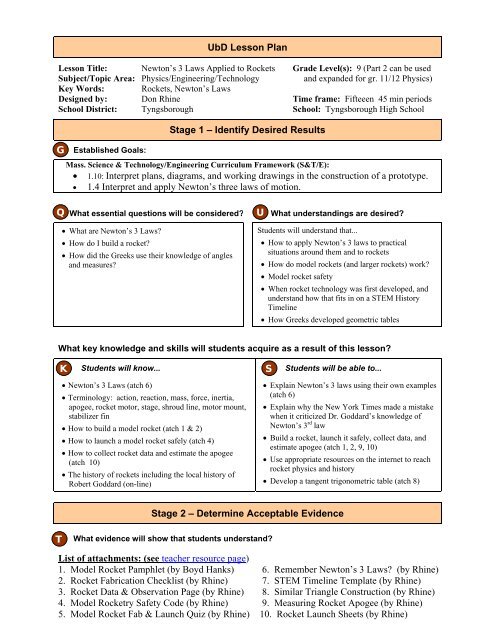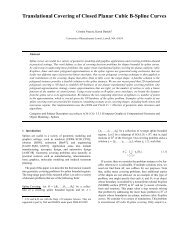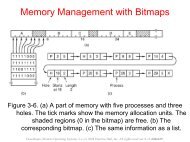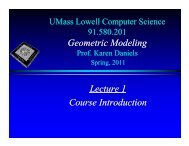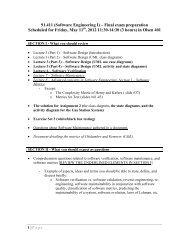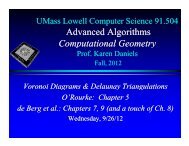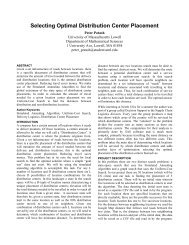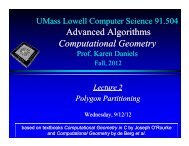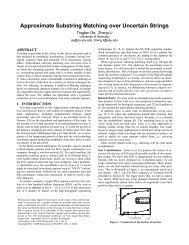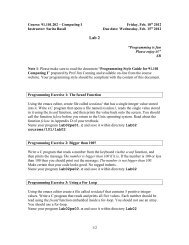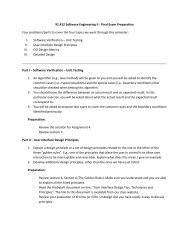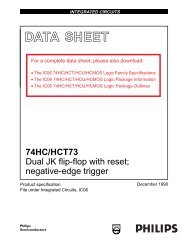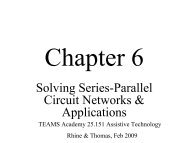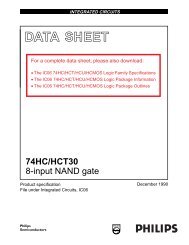CREATING A BUDGET (LESSON PLAN) - Computer Science
CREATING A BUDGET (LESSON PLAN) - Computer Science
CREATING A BUDGET (LESSON PLAN) - Computer Science
Create successful ePaper yourself
Turn your PDF publications into a flip-book with our unique Google optimized e-Paper software.
UbD Lesson Plan<br />
Lesson Title: Newton’s 3 Laws Applied to Rockets Grade Level(s): 9 (Part 2 can be used<br />
Subject/Topic Area: Physics/Engineering/Technology and expanded for gr. 11/12 Physics)<br />
Key Words: Rockets, Newton’s Laws<br />
Designed by: Don Rhine Time frame: Fifteeen 45 min periods<br />
School District: Tyngsborough School: Tyngsborough High School<br />
G Established Goals:<br />
Stage 1 – Identify Desired Results<br />
Mass. <strong>Science</strong> & Technology/Engineering Curriculum Framework (S&T/E):<br />
• 1.10: Interpret plans, diagrams, and working drawings in the construction of a prototype.<br />
• 1.4 Interpret and apply Newton’s three laws of motion.<br />
Q What essential questions will be considered<br />
W<br />
• What are Newton’s 3 Laws<br />
• How do I build a rocket<br />
• How did the Greeks use their knowledge of angles<br />
and measures<br />
U<br />
What understandings are desired<br />
Students will understand that...<br />
• How to apply Newton’s 3 laws to practical<br />
situations around them and to rockets<br />
• How do model rockets (and larger rockets) work<br />
• Model rocket safety<br />
• When rocket technology was first developed, and<br />
understand how that fits in on a STEM History<br />
Timeline<br />
• How Greeks developed geometric tables<br />
What key knowledge and skills will students acquire as a result of this lesson<br />
K<br />
Students will know...<br />
• Newton’s 3 Laws (atch 6)<br />
• Terminology: action, reaction, mass, force, inertia,<br />
apogee, rocket motor, stage, shroud line, motor mount,<br />
stabilizer fin<br />
• How to build a model rocket (atch 1 & 2)<br />
• How to launch a model rocket safely (atch 4)<br />
• How to collect rocket data and estimate the apogee<br />
(atch 10)<br />
S<br />
Students will be able to...<br />
• Explain Newton’s 3 laws using their own examples<br />
(atch 6)<br />
• Explain why the New York Times made a mistake<br />
when it criticized Dr. Goddard’s knowledge of<br />
Newton’s 3 rd law<br />
• Build a rocket, launch it safely, collect data, and<br />
estimate apogee (atch 1, 2, 9, 10)<br />
• Use appropriate resources on the internet to reach<br />
rocket physics and history<br />
• The history of rockets including the local history of<br />
Robert Goddard (on-line) • Develop a tangent trigonometric table (atch 8)<br />
Stage 2 – Determine Acceptable Evidence<br />
T<br />
What evidence will show that students understand<br />
List of attachments: (see teacher resource page)<br />
1. Model Rocket Pamphlet (by Boyd Hanks) 6. Remember Newton’s 3 Laws (by Rhine)<br />
2. Rocket Fabrication Checklist (by Rhine) 7. STEM Timeline Template (by Rhine)<br />
3. Rocket Data & Observation Page (by Rhine) 8. Similar Triangle Construction (by Rhine)<br />
4. Model Rocketry Safety Code (by Rhine) 9. Measuring Rocket Apogee (by Rhine)<br />
5. Model Rocket Fab & Launch Quiz (by Rhine) 10. Rocket Launch Sheets (by Rhine)
Performance Tasks:<br />
• Reading Comprehension: Read instructions for fabricating rockets (atch 1) , safety, and historical references<br />
• Fabricate a model rocket in teams of two – see grading rubric (atch 2)<br />
• Writing:<br />
• Take notes on key portion of assigned reading (assign grade)<br />
• Summarize rocket safety<br />
• Notes from Goddard and Newton research<br />
• Discussion: Examples of Newton’s Laws to develop understanding and relate to student examples and rocket<br />
examples. Discuss misconceptions related to Newton’s Laws including…<br />
o the New York Times invalid criticism of Goddard (Newton’s 3 rd Law)<br />
o Historical and present-day misconceptions related to inertia, medieval impetus concept, and<br />
motion<br />
• Launch rocket safely, collect data, and analyze results<br />
OE<br />
What other evidence needs to be collected in light of the desired results<br />
Other Evidence:<br />
• Quiz – Rocket structure and function (atch 5)<br />
• Worksheet – Newton’s Laws (atch 6)<br />
• Template – STEM Timeline<br />
SA Student Self-Assessment and Reflection:<br />
• Write a brief summary of the article/paper and discuss how the engineering design cycle was used by the<br />
engineers in the article/video.<br />
• See steps 6 & 10 in Stage 3.<br />
List of attachments: (see teacher resource page)<br />
1. Model Rocket Pamphlet (by Boyd Hanks) 6. Remember Newton’s 3 Laws (by Rhine)<br />
2. Rocket Fabrication Checklist (by Rhine) 7. STEM Timeline Template (by Rhine)<br />
3. Rocket Data & Observation Page (by Rhine) 8. Similar Triangle Construction (by Rhine)<br />
4. Model Rocketry Safety Code (by Rhine) 9. Measuring Rocket Apogee (by Rhine)<br />
5. Model Rocket Fab & Launch Quiz (by Rhine) 10. Rocket Launch Sheets (by Rhine)
Stage 3 – Plan Learning Experiences<br />
L<br />
WHERETO<br />
What sequence of teaching and learning experiences will equip students to engage with, develop, and demonstrate the desired<br />
understandings List key teaching and learning activities in sequence.<br />
Links to teacher resource page and student web site<br />
Part 1: Introduce Rocket Topic (first 1/2 of Period 1)<br />
1. Materials needed:<br />
a. Launch stand loaded with four rockets (visual demo)<br />
b. Internet video – Goddard Bio (links on Rhine Rocket Website)<br />
c. Student three-ring binders with attachments printed (students can assemble)<br />
2. Show students launch stand with loaded rockets and describe plan for next two weeks (fab rockets,<br />
understand rocket safety and function of rocket components, how one might measure the apogee, and in<br />
introduction to the history of rockets and related physics (Goddard, Newton)<br />
Part 2: Fabricate Rockets (5 ½ periods)<br />
1. Materials needed: (set up kits in project boxes for students beforehand)<br />
a. Rocket kits (from Pitsco Education, $4 each, can share 2-3 students per kit). Pre-fab fins and cut<br />
piece gum tape and length of shroud line.<br />
b. Project Box<br />
c. Other materials tools & materials listed in Atch 2.<br />
d. Archs 1, 2, 3, 4 will be used<br />
e. Sample A, B, C, and D unused and used ocket motors (with digital scales and calipers to measure)<br />
(Atch 3)<br />
f. Newton’s Law Worksheet (Atch 6)<br />
2. Second ½ of Period 1 - Have students inventory kits (using Atch 2) and read through first five pages of<br />
pamphlet (Atch 1) and take notes. Tell students notes can be used on upcoming quiz!<br />
3. Successive periods: Tell students to divide tasks and work in parallel! Students will use atch 2 fab<br />
checklist to guide work. As students complete the tasks, they can bring to the instructor to inspect and<br />
receive a grade (use Atch 2).<br />
g. Period 2: Fab airframe and in parallel fab motor mount and parachute. Mount (glue) first fine to<br />
airframe and lightly fold with masking tape. Set aside to dry.<br />
h. Period 3: Finish parachute and mount shock cord. In parallel, mount second fin & glue motor<br />
mount into airframe. Set aside to dry.<br />
i. Period 4: Finish parachute and shock cord assembly. Hand out A size rocket engine and have<br />
student insert and pack rest of rocket for first launch. Mount third fin & glue motor mount into<br />
airframe. Set aside to dry.<br />
j. Period 5. Give and overview of how to pack rockets properly. Show students different size rocket<br />
engines and ask them to read safety code and rocket engine info handout, then answer questions in<br />
Atch 3.<br />
k. Period 6 – catch-up period – students can decorate rockets and use computers to start Newton’s<br />
law homework (Atch 6). Can give quick quiz on rockets (Atch 5)<br />
List of attachments: (see teacher resource page)<br />
1. Model Rocket Pamphlet (by Boyd Hanks) 6. Remember Newton’s 3 Laws (by Rhine)<br />
2. Rocket Fabrication Checklist (by Rhine) 7. STEM Timeline Template (by Rhine)<br />
3. Rocket Data & Observation Page (by Rhine) 8. Similar Triangle Construction (by Rhine)<br />
4. Model Rocketry Safety Code (by Rhine) 9. Measuring Rocket Apogee (by Rhine)<br />
5. Model Rocket Fab & Launch Quiz (by Rhine) 10. Rocket Launch Sheets (by Rhine)
Part 3: Discussion of Newton’s Laws and Rocket History (4 Periods)<br />
3. Period 1: Historical Context Discussion.<br />
a. Materials Needed: Slide presentation related to STEM Historical figures<br />
i. Briefly review “standard wording” of Newton’s 3 Laws<br />
ii. Begin with an overview of Newton’s place in history and discuss the relative importance<br />
of his work and relate to his predecessors such as Archimedes, the large time gap<br />
between Archimedes and Galileo, Galileo, Newton. 1 Discuss the development of these<br />
fundamental ideas and how the historical figures tried to describe the physical world<br />
based on their preconceived notions and their use of scientific method (or lack of it). 2<br />
iii. Discuss STEM Timeline project (set deadline of 2 – 3 weeks) – use this to have students<br />
explore other key figures in STEM history.<br />
4. Period 2: Newton’s 3 Laws fun class demos<br />
a. Materials needed: Atch 6, fun demonstration apparatus for Newton’s 3 Laws (hoverboards, etc.).<br />
The hoverboard is a 4 foot diameter circular hoverboard powered by a leaf blower. One or more<br />
students can sit on hoverboard and other students can push.<br />
b. Give an example of each law using a demo to show students (hoverboard can be used for all three<br />
demos).<br />
i. 1 st law – hoverboard moving at constant velocity contrasted with box or chair sliding to a<br />
stop when pushed and let go<br />
ii. 2 nd law – can add 1, 2, 3 students to hoverboard and demonstrate amount of force<br />
required to start them moving or stop them increases. Can pull with spring scale at<br />
“constant force” and show how rate of acceleration is lower with more students on<br />
hoverboard. Works best using 2 hoverboards side-by-side.<br />
iii. 3 rd law – Action-reaction pairs—using large spring scales (or bathroom scales), demo<br />
how as teacher pulls (pushes), student experience same pulling force in opposite direction<br />
(can do either to start students moving or slow students down). This is a good time to<br />
discuss the misconception that a lager object exerts a larger force on a smaller object.<br />
c. Come up with 3 more examples using student ideas and draw on board, discuss and make sure<br />
concept is clear.<br />
d. Assign HW from Atch 6: students come up with three new examples for next day cannot use class<br />
examples or rockets).<br />
5. Period 3: Newton’s 3 Laws: Rocket Applications & Goddard Historical Example of Newton’s 3 rd Law<br />
Dispute with the New York Times<br />
a. Materials needed: Atch 6, on-line Rocket Launch video, balloons.<br />
b. Start by showing Goddard 5-min video (link on Rhine web site).<br />
c. Next step through each of 3 laws and have students relate to rockets, then discuss their answers as<br />
a class. Can contrast small vs. large rockets, rockets on earth vs. in space (effects gravity vs. no<br />
gravity, air vs. no air). Hold off on balloon demo!!<br />
d. One key misconception to look for is Newton’s 3 rd law. Some students will probably think that<br />
the rocket’s engine exhaust push on the ground, and the ground pushes back on the rocket. At this<br />
point can discuss famous Goddard vs. NYT dispute (see links on line). Show balloon demo after<br />
1 Toulmin, S. and Goodfield, J. (1962) The premature synthesis (Chap. 3); The creation of mechanics (Chap. 8). In<br />
The fabric of heavens: the development of astronomy and dynamics. (pp. 90 – 105; 210 - 227). New York: Harper &<br />
Row.<br />
2 McCloskey, M. (1983). Intuitive Physics. Sci. Am., 248 (4), 122-130.<br />
3 Excerpts from New York Times editorial criticizing Dr. Goddard (M. Gruntman, Blazing the Trail, page 117,<br />
AIAA, 2004).<br />
List of attachments: (see teacher resource page)<br />
1. Model Rocket Pamphlet (by Boyd Hanks) 6. Remember Newton’s 3 Laws (by Rhine)<br />
2. Rocket Fabrication Checklist (by Rhine) 7. STEM Timeline Template (by Rhine)<br />
3. Rocket Data & Observation Page (by Rhine) 8. Similar Triangle Construction (by Rhine)<br />
4. Model Rocketry Safety Code (by Rhine) 9. Measuring Rocket Apogee (by Rhine)<br />
5. Model Rocket Fab & Launch Quiz (by Rhine) 10. Rocket Launch Sheets (by Rhine)
discussion NYT mistake.<br />
e. Hw: assign reading related to Goddard dispute with NYT. 3 Ask students to find when NYT<br />
finally admitted their mistake (another historical date). 4<br />
6. Period 4: Finish up discussion of Newton’s Laws and give a quick quiz on Newton’s 3 Laws.<br />
Part 4: How to measure rocket’s Apogee (2 Periods) - Mathematics/Geometry Content<br />
Detailed instructions for teacher to be completed later. See finished handouts (Atchs 8 & 9)( fairly selfexplanatory).<br />
Part 5: Rocket Launch and Data Collection (2 Periods)<br />
Detailed instructions for teacher to be completed later. See finished handouts (Atchs 10) (fairly selfexplanatory)<br />
4 A description of Goddard's reactions to the New York Times Editorial (from Clark University's on-line Archives &<br />
Special Collections)<br />
List of attachments: (see teacher resource page)<br />
1. Model Rocket Pamphlet (by Boyd Hanks) 6. Remember Newton’s 3 Laws (by Rhine)<br />
2. Rocket Fabrication Checklist (by Rhine) 7. STEM Timeline Template (by Rhine)<br />
3. Rocket Data & Observation Page (by Rhine) 8. Similar Triangle Construction (by Rhine)<br />
4. Model Rocketry Safety Code (by Rhine) 9. Measuring Rocket Apogee (by Rhine)<br />
5. Model Rocket Fab & Launch Quiz (by Rhine) 10. Rocket Launch Sheets (by Rhine)


